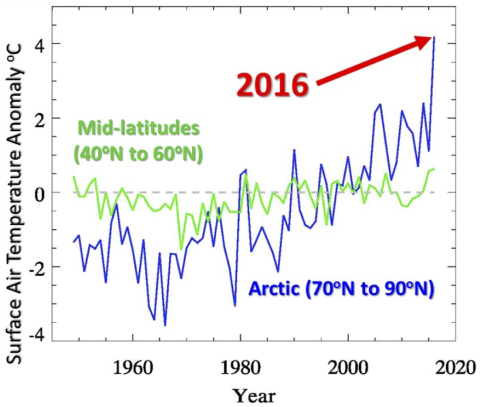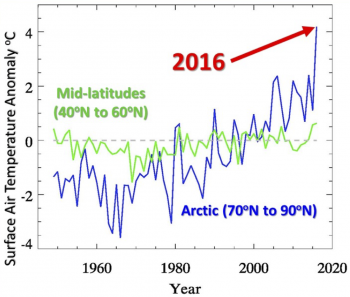

The Issue
Effects of the Arctic Meltdown on U.S. Weather Patterns In recent decades, the pace of Arctic warming was at least double that of the globe. A growing body of research suggests this differential warming will increase the frequency of extreme weather events in the United States and elsewhere in the northern hemisphere.
Why It Matters

Extreme weather events cause billions of dollars in damage, scores of deaths and injuries, and thousands of disrupted lives each year. The frequency of these events is increasing, and certain types have clear links to climate change. Rapid Arctic warming is expected to cause more persistent weather regimes that can lead to devastating drought, heat waves, fire seasons, stormy winters, and flooding, many of which have been prominent weather stories across the U.S. in recent years.
State of the Science
The major wind systems of the globe are driven by temperature differences; the jet stream exists because the Arctic is much colder than regions farther south, the so-called mid-latitudes. The larger the temperature difference, the stronger the jet stream. Any changes that affect the Earth’s temperature patterns will also affect jet streams, and because jet streams create and steer weather patterns, those changes will also affect mid-latitude weather. The dramatic Arctic warming during recent decades is reducing this temperature difference, which is weakening the jet stream’s west-to-east winds.1 Instead of a coherent river of strong winds, a weaker jet tends to waver, split, and wander north and southward on its path around the northern hemisphere.2,3 These wavier jet streams are responsible for a variety of extreme weather events, which have become more frequent in the U.S., Canada, Europe, and Asia.4,5
The linkage between amplified Arctic warming and mid-latitude weather is a rapidly evolving field of research. New evidence suggests that diminished sea ice in particular regions and seasons has distinct effects on weather extremes.6 Ice loss and warming north of Alaska, for example, allows extra summer sunshine to warm those waters. Come autumn, that heat is released back into the atmosphere, which intensifies northward swings in the jet stream – known as ridges – in the area of ice loss. The "Ridiculously Resilient Ridge" largely responsible for California's ongoing extreme drought was likely strengthened by the warm Arctic.7 Like a whipped jump rope, the effect downstream was a more southerly jet excursion – or trough – which allowed cold air to plunge into eastern states during winters of 2013/14 and 2014/15. Larger jet waves tend to linger in one place, favoring persistent weather patterns: relatively warm and dry under the ridge, cold and stormy in the trough. Prolonged summer heat waves and flooding caused by slow-moving storms may also get a boost from the Arctic meltdown.2
Where the Science is Headed

While some mechanisms linking the rapidly warming Arctic and changes in mid-latitude weather are becoming clear, others are more difficult to identify because the atmosphere is such a chaotic beast. Challenges arise because the era of rapid Arctic warming began only a decade or two ago, other changes in the climate system are happening simultaneously, and natural fluctuations (such as El Niños/La Niñas) obscure signals.8 Standard analysis methods that average over large areas or time periods may smear unusual jet features that don't appear in the same location each year. Computer models of the climate system struggle to realistically simulate very wavy jet features and complex Arctic processes, thus their utility for studying mechanisms of Arctic/mid-latitude linkages is imperfect. Much is left to unravel, but research is progressing quickly.
Key References
- Francis, J.A., and S.J. Vavrus, 2012. Evidence linking Arctic amplification to extreme weather in mid-latitudes. Geophys. Res. Lett., 39, LO6801, doi:10.1029/2012GL051000.
- Coumou, D., J. Lehmann, and J. Beckmann, 2015.The weakening summer circulation in the Northern Hemisphere mid-latitudes, Science, 348 (6232), 324–327, doi:10.1126/science.1261768.
- Francis, J.A., and S.J. Vavrus, 2015. Evidence for a wavier jet stream in response to rapid Arctic warming. Environ. Res. Lett., 10, doi:10.1088/1748-9326/10/1/014005.
- Screen, J.A., and I. Simmonds, 2014. Amplified mid-latitude planetary waves favor particular regional weather extremes. Nat. Climate Change, 4, doi:10.1038/nclimate2271.
- Rahmstorf, S., and D. Coumou, 2011. Increase of extreme events in a warming world. Proc. Natl. Acad. Sci. USA, 108, doi: 10.1073/pnas.1101766108.
- Kug, J.-S., J.H. Jeong, Y.-S. Jang, B.-M. Kim, C.K. Folland, S.-K. Min, and S.-W. Son, 2015. Two distinct influences of Arctic warming on cold winters over North America and East Asia, Nat. Geosci., 8, doi:10.1038/ngeo2517.
- Swain, D.L., D.E. Horton, D. Singh, and N.S. Diffenbaugh, 2016. Trends in atmospheric patterns conducive to seasonal precipitation and temperature extremes in California. Sci. Adv. 2, doi:10.1126/sciadv.1501344.
- Barnes, E.A., and J.A. Screen, 2015. The impact of Arctic warming on the midlatitude jet-stream: Can it? Has it? Will it? WIREs Clim Change doi: 10.1002/wcc.337.
Contacts
Dr. Jennifer Francis francis [at] imcs.rutgers.edu
Dr. Stephen Vavrus sjvavrus [at] wisc.edu
| Attachment | Size |
|---|---|
| aa-001_june2017_lower-latitude-weather.pdf435.81 KB | 435.81 KB |
